Organic life beneath the shoreless waves
Was born and nurs’d in ocean’s pearly caves
First forms minute, unseen by spheric glass
Move on the mud, or pierce the watery mass
These, as successive generations bloom
New powers acquire and larger limbs assume
Whence countless groups of vegetation spring
And breathing realms of fin and feet and wing
—Erasmus Darwin, The Temple of Nature (1802)
In the summer of 1976, Neil Shubin got caught up, along with the rest of the city of Philadelphia, in the celebration of the American Bicentennial. Having grown up in the birthplace of the Revolution, Neil was surrounded by Colonial history. That year he took a strong interest in the archeology of various ruins around the city. Though just a high school student, Neil got the chance to work under the guidance of a University of Pennsylvania professor on unearthing the history of some old local paper mills.
His assignment was to determine what one particular mill produced. Every day, no matter how hot and muggy it was, Neil went to the ruins of the mill site along the banks of Mill Creek and dug in the dirt for clues. It was fun to find pot shards and old tools, but it was also hard, messy work. Neil figured there had to be other ways to find out about the past than just through physical artifacts. He got the idea that he might be able to find some clues to the mill’s history at the library. Scouring microfilm records of 19th-century trade journals and newspapers, his detective work paid off. He was able to trace the name of the mill, the cause of the fire that destroyed it, and to discover just what the mill did. When his professor told him that he got the story right, Neil was very proud of his first archeological success. And he learned three lessons that would serve him well in the years to come—that the past was knowable, that he loved field work, and that it paid to do one’s homework.
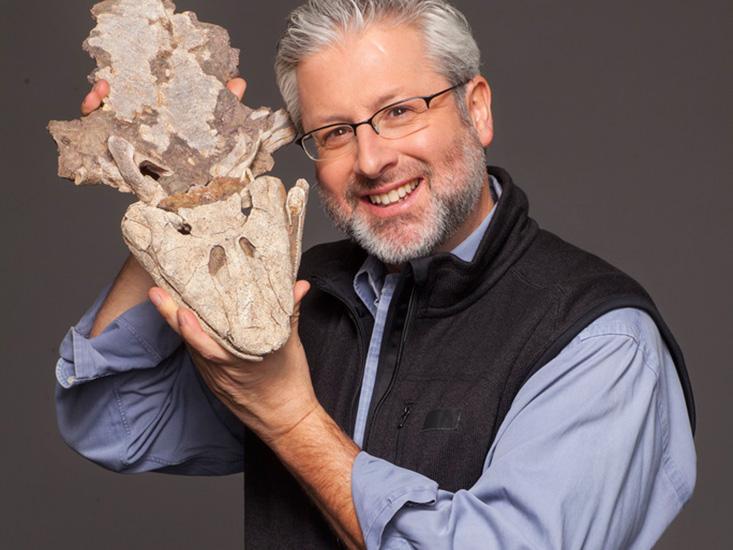
Upon entering Columbia University, Neil soon discovered that there were even bigger mysteries lurking in the history of life, and decided that paleontology, not archeology, was his calling. He entered graduate school at Harvard eager to go on expeditions and to find fossils. Under the tutelage of Farish Jenkins, his Ph.D. advisor, he got his first chance, looking for early mammal fossils in sites Farish had discovered in Arizona. That experience taught Neil crucial field skills—how to spot teeth and bone amongst a sea of rock and, as these were often tiny, delicate fossils, he also learned the patience necessary to scour an exposure with a hand-held lens to find and extract individual gems. The search for such buried treasures gave Neil the appetite to find his own fossil sites and to launch his own expeditions.
The mammal fossils he was after were 200-million-year-old rocks. Lacking any funds for more exotic locales, Neil rented a minivan and drove to nearby Connecticut where rocks of that age had been known for a long time. But he found zilch. In Connecticut, most of the rock was covered with forest and other greenery; he needed larger exposures than the occasional highway road cut—such as a seacoast.
It was time to do some homework. In the geology library, he learned that rocks of the right age were also not far away in Nova Scotia and, better yet, they were pounded by some of the highest tides in the world. He’d have plenty of exposed areas to search. Farish supported the expedition and Neil brought several more experienced hands to explore the seacoast in the Bay of Fundy. They found a lot of fossils, including a tiny jaw with unusual teeth that had characteristics of both reptiles and mammals. It belonged to a creature called a trithelodont, a transitional fossil between reptiles and mammals, a great find. The next year, Neil and his colleagues collected three tons of fossil-bearing rock that contained thousands of teeth and bones of these creatures, crocodiles, and lizard-like reptiles.
Tracking the origin of mammals from reptilian ancestors stoked a particular interest in some of the great evolutionary transitions in life’s history. A second major milestone, the origin of four-legged vertebrates from fish ancestors, soon moved to the forefront. When Neil joined the University of Pennsylvania as a new assistant professor in the late 1980s, he was determined to uncover some of the missing links among some of our earliest backboned ancestors.

Neil and Ted’s Excellent Adventures
The key period for vertebrates coming onto land is within the late Devonian, specifically from about 385 to 365 million years ago. Prior to this time, vertebrates were represented only by fish. By the end of the Devonian (about 359 million years ago), life on land was changing in dramatic ways—vertebrates had evolved limbs and started to walk, and insects and spiders had also entered terrestrial habitats.
In the vertebrate fossil record, a few key fossils mark some of the stages of the fin-to-limb transition and the origin of four-legged vertebrates (tetrapods). For example, fish such as Eusthenopteron and Panderichthys are known from about 385 to 380 million years ago and show in their fins some of the same basic bone structures, the presence of one upper “arm” bone and two “forearm” bones, as those found in tetrapod limbs (see The Origin of Limbs). But these ancient fish do not have the equivalent of wrists or fingers. By roughly 365 million years ago, the full suite of tetrapod limb characteristics are present in animals such as Acanthostega. Discovered on the east coast of Greenland, one of the most surprising features of this animal are the eight digits on its hands (and at least that many on its feet), which reveal that the early condition in tetrapods was the possession of more than the five digits common to all recent forms.
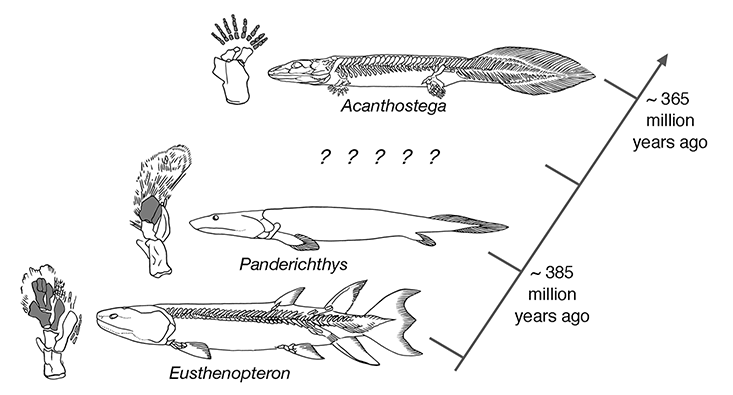
But as great a fossil as Acanthostega is, at the time Neil began his studies, there was quite a gap between its fully formed limbs and the fins of earlier fish. That was the gap that Neil, and his new graduate student Ted Daeschler, aimed to close.
Fortunately for Neil and Ted, the commonwealth of Pennsylvania sits on a lot of Devonian rock. Three-hundred-eighty million years ago, the Acadia mountain range was drained by a series of meandering rivers that emptied into the inland Catskill Sea. The resulting Catskill Delta now lies in the present day Appalachians, with ancient floodplain deposits extending from southeastern New York through Pennsylvania, Maryland, and West Virginia. So, luckily, Neil and Ted would not have to go far to go prospecting. But, just as in Connecticut years earlier, the rock was largely covered with greenery and urban development, and there was no seacoast. The best they could do was to scout highway road cuts, which at least had the advantages of being easily accessible and very inexpensive field trips.
For several years over the first half of the 1990s, Neil and Ted embarked on a series of roadside adventures. On State Route 120, they found a newly blasted exposure of late Devonian rock called Red Hill. They first found a few fish scales there and then, while Neil was off in Greenland on another expedition, Ted returned to the site and found the shoulder of a tetrapod—the first late Devonian tetrapod discovered outside of Greenland. Comprising about 75 vertical feet of rock formed from about 400,000 years of Devonian deposits, the hill was loaded with fossils. With such easy access, Neil and Ted could haul anything back to the lab at Penn for closer inspection.
Route 15 provided another bonanza. Combing through some freshly blasted boulders, Neil and Ted carted a few big hunks back for further analysis. They spotted a large fish fin poking out of one boulder, but it was not the sort of fin they usually found. This one had bones inside. A month’s worth of preparation revealed a fin with one bone attaching to the shoulder, two bones attached to it, and eight rods extending out from the fin. Those eight rods looked like they could be forerunners of digits, the eight digits that appeared in animals like Acanthostega.
Their “fish with fingers” and three different tetrapods gathered from road cuts were valuable new fossils, and a great bounty for a few years effort but, alas, they weren’t filling that fish-tetrapod gap. Since tetrapods and various fish co-existed at Red Hill, it became clear that the rocks were too recent (Red Hill was 361-362 million years old). The key transition had already taken place some time earlier.
If they were to find transitional fossils, they had to look at rocks that were a bit older. They had learned what the right kinds of rocks were from Red Hill and other road cuts. Fossils were best preserved in deposits at the margins or overbanks of ancient streams that were part of delta systems. But where in the world might they find such rocks that others had not already explored?
They considered China, South America, and Alaska, but the prospects did not look encouraging. Then one day, in the course of settling an entirely unrelated geological squabble, they opened an old undergraduate geology textbook and happened upon a map showing several late Devonian deposits in North America. It showed East Greenland—but Neil and many others had been there and done that. It showed the Catskill Formation, where they had now toiled for years. And it showed the Canadian Arctic Islands—a vast and, paleontology-wise, virgin territory.
Excited, they went off to discuss a possible expedition over lunch at their favorite Chinese restaurant. After eating his Kung Pao chicken, Neil opened his fortune cookie and read: “You will soon be at the top of the world.”
A Treasure Map
If Neil was to find his fortune at the top of the world, he and Ted would need to do their homework. The first order of business was to find a damn good map. The Arctic Islands encompass tens of thousands of square miles and include a number of uninhabited islands in one of the most remote parts of the planet. That is a lot of territory to cover and, because of the extreme climate, they would have a very short window of time to scout and to decide where to dig. They needed to narrow their search somehow.
Fortunately, many of the remote places of the world are of interest to more than just a small tribe of paleontologists. For many decades, the major oil and gas companies and various governments have surveyed them for prospective natural resources. And, fortunately for Neil and Ted, the Geological Survey of Canada and a host of major oil companies had sponsored an extensive survey of the Arctic Islands. They found their treasure map published in the Bulletin of Canadian Petroleum Geology, cleverly disguised under the title “The Middle-Upper Devonian Clastic Wedge of the Franklinian Geosyncline.”
Weighing in at 154 pages, the paper by Ashton Embry and J. Edward Klovan was the fruit of four years of work in the early 1970s mapping out the geological formations of the various islands. For two months each summer between late June and late August, the only months during which field work was possible, and constantly hampered by fog, snow, rain, and high winds, Embry and Klovan made their way across the Canadian Arctic by helicopter and light airplane, taking measurements and samples at every step.
Neil and Ted followed Embry’s tracks by combing their way through page after page of the descriptions of the geology of the various rock formations exposed on the islands, looking for hints of where to go. And then, buried deep in the paper in the discussion of the so-called “Fram Formation” which ran across southern Ellesmere Island, they hit the sentences that had them ready to pack their bags:
“the … fossil content of the Fram Fn [Formation] suggest a meandering-stream environment of deposition. Sandstone units are interpreted to be point-bar and channel-fill deposits, whereas the shale siltstone units are of overbank origin.
The Fram Fn is similar to the Catskill Fn of Pennsylvania [italics added] …”
Embry and Klovan thoughtfully included a representative photo of these deposits.

But this terrain was even better than the Catskills, for in this part of the world there was virtually no vegetation covering the rocks. They had endless exposures they could survey.
So the Fram Formation was their target, but the next question was how to get there? They figured the best way to find out was to track down Ashton Embry, some 23 years after his survey. Neil and Ted flew to Calgary to meet with Embry’s team of savvy veterans who had been traveling throughout the Arctic every summer. They explained their Catskill work and presented their ideas for exploring the Arctic.
“Great idea. You are going to find what you are looking for,” Embry assured them.
The Canadians’ expertise in geology and logistics was priceless. Getting around the islands was complex. There were very few settlements or airfields. The distances involved were beyond the normal range of helicopters and required a system of fuel depots that enabled helicopters to island-hop.
Beyond these logistics, there were the matters of funding and planning the expedition. They soon received a generous commitment from an anonymous donor that would cover all of their costs. With respect to planning, Neil’s former advisor, Farish Jenkins, had extensive experience in organizing field studies in Greenland, so Neil invited him aboard as a partner, and Farish readily accepted. The expedition would then consist of three academic generations: Farish, Neil’s thesis advisor; Neil, Ted’s thesis advisor; and Ted.
By spring of 1999, plans were well along for a six-week trip that summer. The team was buying supplies and working out the travel logistics. With the certain uncertainty of the weather, every contingency had to be considered. But, at $2,000/per hour for helicopter time, and limited cargo capacity, they had to be very disciplined about the supplies they brought.
There was also the matter of permits. The expedition was headed into Nunavut Territory, which was controlled by the Inuit people, and they required permission from the local Ministry and the Hamlet of Grise Fiord. This settlement of 140, the northernmost village in North America, would be the team’s last destination before venturing off into completely uninhabited terrain. Everything was going along as planned, until a second group, the hunters and trappers association, refused to grant a permit out of concern that the team’s aircraft would disturb the wildlife. It was a big setback, but the team was determined to go to the Arctic. They shifted their plans away from Ellesmere Island to Melville Island in the west.
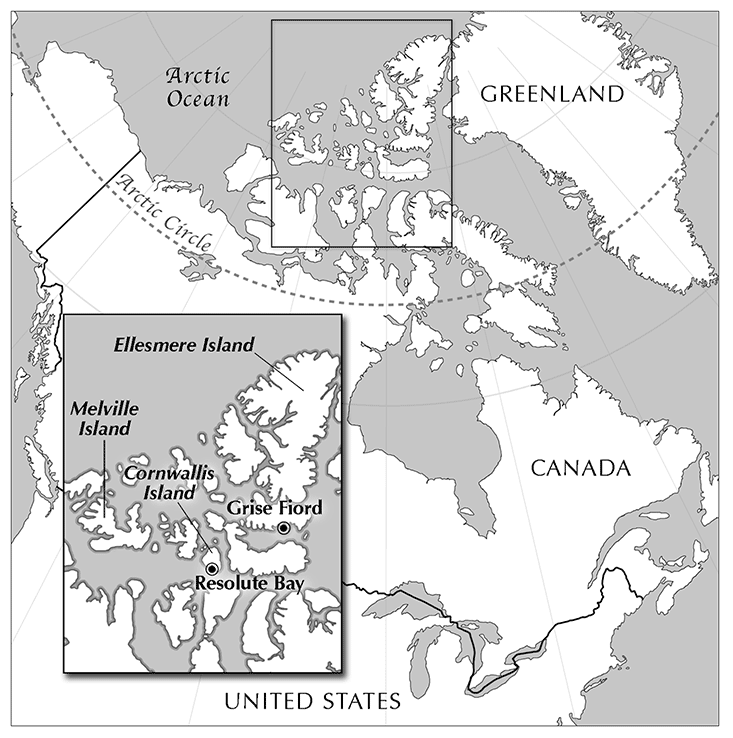
Melville Island
The staging point for reaching Melville is a small Inuit hamlet on Cornwallis Island called Resolute Bay. With about 20o inhabitants, it serves as an aviation hub and houses a grocery store and three hotels—which as it turns out was fortunate for the six-person field team, as they were grounded there by several days of bad weather.
They were also a bit unsettled by small talk with the locals. When asked where they were headed, “Melville Island!” was the team’s enthusiastic reply.
The natives shot back a look of “Oh, you are not really going there, are you?” They could not think of any good reason to go to such a desolate place. Neil was not encouraged, “It was like saying we were going to Castle Dracula for dinner.”
Time was precious and they had to be ready to go at the slightest break in the weather. When the veteran bush pilot finally got them aloft in his twin engine Otter plane, they were wishing they had waited longer. It was a scary ride. They were enshrouded in fog the whole way, looking for a fog-covered island. The pilot made several passes before plunking the plane down on the tundra. They unloaded all of the gear, the pilot wished them luck, and he was gone.
The first thought on Neil’s mind? Survival.
And the first order of business? To load the rifles! This was known polar bear country.
Then they set up the tents and made camp. They would have 24-hour daylight, freezing cold temperatures, and a lot of wind for the next six weeks. They had to brace the tents with rocks. They also set up a trip-wire system around the tents. Should a polar bear stray into camp, it would trigger a alarm and give everyone a few moments to grab their weapons.
After a long day, they finally settled in for the “night.”
Less than an hour later, the alarm went off.
Everyone scurried out of their sleeping bags and appeared, rifles ready. It was a false alarm; the wind had blown over one of the poles holding the trip-wires. Still on edge, everyone tried to get back to sleep.
Thirty minutes later, the alarm sounded again.
The same drill, and yet another false alarm. This time a wire came loose.
Twice more the first night the alarm went off. The team leaders said to hell with it, and turned the whole system off for good.
Besides worrying about becoming a polar bear’s breakfast, Neil had other concerns. Here they were, isolated in a scary, desolate, and very unfamiliar place, for quite a long time. Would they find anything?
The first thing paleontologists want to do in a new location is to scout. They hiked to a hill behind the camp and promptly found some fossil fish scales. Good enough, they had reason to hope.
Their only contact with the outside world was by radio. They set up the antenna so they could make their two pre-arranged calls each day to check in and to let their logistics support team know they were OK and when they were needed to move to a second camp. They continued to find fossils at the second camp. But it became clear they were looking at deposits of a deep-water marine environment and not the shallow stream beds and overbanks they wanted.
In the fourth week, the weather set in. For 13 straight days the wind blew at 30 to 50 miles per hour. They were stuck in their tents. Soon they had read all of their own books and those everyone else had brought along for just such a contingency, from Bill Bryson and Carl Hiaasen to Tolstoy. Neil then passed the time perfecting pocket rockets—matchhead-powered aluminum foil missiles that once perfected, and Neil had a lot of time to perfect them, could shoot 20 feet across the tent.
Then it was time to go home. The long expedition was a bust. Morale had slipped. If they were going to come back to the Arctic, they had to get to Ellesmere Island and the heart of the Fram Formation.
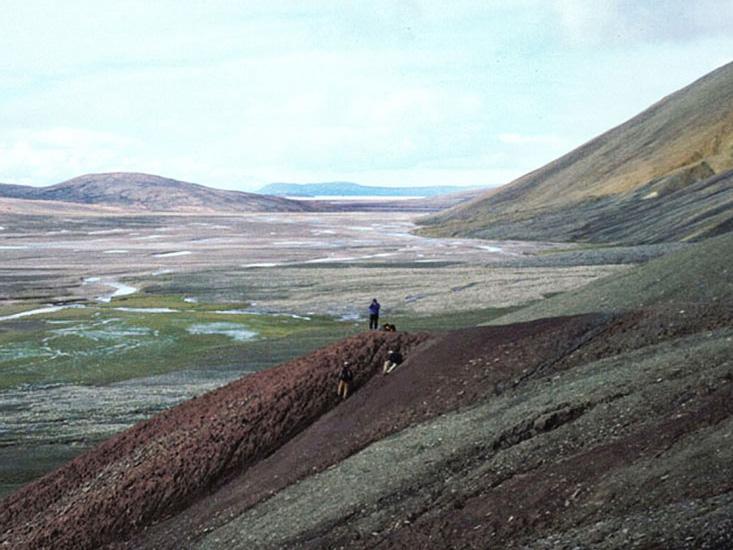
Ellesmere
They got their permits in time for the summer 2000 field season, including the OK from the hunters and trappers. They flew to Grise Fiord at the southern end of Ellesmere and went by helicopter to a section of the Fram Formation described by Ashton Embry.
The full field crew this year was a team of nine including Neil, Ted, and Farish. It took a lot of supplies to house, feed, and equip a crew so far from even an outpost such as Grise Fiord. Everything had to be helicoptered in and out.
But at the same time, the team leaders could not be too spartan. The 24-hour daylight, all of the walking, the wind and cold, and the hard work would drain the energy of the most enthusiastic fossil prospector. Neil dropped 20 pounds in the course of the season. A few comforts and rituals were necessary to maintain team spirit, and physical strength.
For Neil, a nice martini was his reward at the end of the day. So he packed a martini shaker, plastic glasses, and vermouth. But he was pained to find out that at camp, above the Arctic Circle and just 10 degrees of latitude below the North Pole, global warming had destroyed his perfect cocktail—there was no ice! He decided not to call the radio base to ask them to send up some ice, and made do.
With lots of field experience between them, the team leaders knew that dinner time was crucial to maintaining morale and camaraderie. While they packed military MREs (meals, ready-to-eat), those were for emergency use. They spent part of the spring dehydrating food in the lab and packing some tasty meals, complete with all sorts of sauces and spices, to perk up “Café Ellesmere.” The menu, carefully designed to provide a new set of flavors each day, included pasta in red sauce, risotto, white chili with turkey, shepherd’s pie, “Parry Islands” gumbo with crabmeat, Tuscan stew, “Aloo Gobi” curry, and other dishes.
Using just a propane stove and fresh water from a nearby stream, the crew rotated cooking duty. The evening ritual of meal preparation and dinner provided a chance to talk about the day and to plan for the next. After dinner, clean up, and a radio call to base, some card games passed the time until about 9:30, when everyone hit their sleeping bags—in their private individual tents (with six weeks under these conditions they could not take the risk of roommate problems).
But sometimes rituals and even dinner had to be put aside. One day late in the field season, one of the undergraduate students on the crew, Jason Downs, did not return to camp by dinnertime. With polar bears in the area, potential bad weather, and the possibility of injury or getting lost, the team was getting worried and preparing to mount a search when Jason finally appeared. Before they could get his story, he started pulling handfuls of fossils out of his pants, jacket, and backpack. He had stumbled upon a trove of fossils only a mile from camp and carried back all he could.
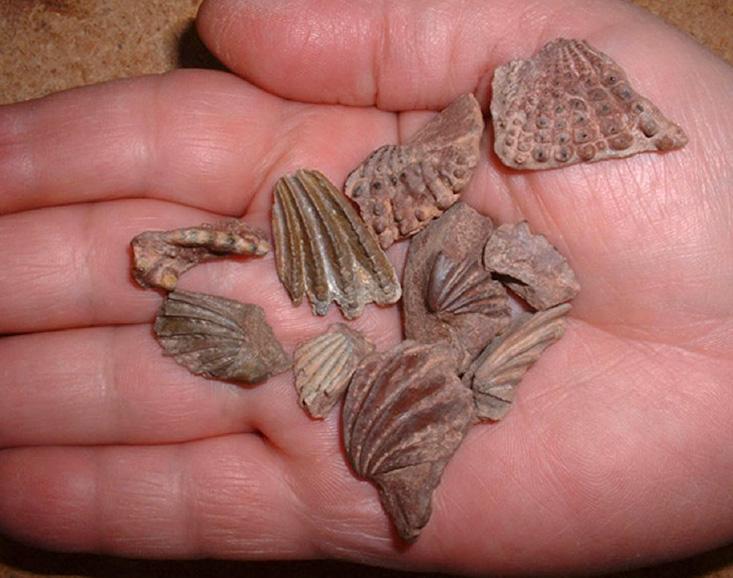
With round the clock daylight there was no need, nor any patience, to wait until the next day. Forgoing dinner, the crew grabbed some candy and energy bars and headed off to see Jason’s site. They crawled all over it, picking up fossils and trying to figure out where and how to excavate it. There was definitely more there than just the teeth and scales they had been finding elsewhere. Digging revealed layers of fossil fish skeletons.
But they weren’t in Pennsylvania and they had no pick-up truck or mini-van. The only way to find out what was really there was to encase boulders of fossil-bearing rock in plaster jackets and to airlift them back to Grise Fiord and then to fly them back to the prep labs in Chicago and Pennsylvania for detailed examination. They could only bring back a few large jackets.
When the jackets were opened and the rock carefully removed from the bones, a number of different fish were revealed—lungfish and some other lobe-finned fish, and a few placoderms. Unfortunately, all of the fish had been found before in Latvia. The disappointment highlighted yet another risk of undertaking expeditions—even if fossils are found in a new location, the fossils themselves may not be new or informative.
But the team remained upbeat and resolved to try again. They did not have much time at the new quarry they had dug in 2000; in the next field season they would focus on the quarry and prospect some new sites. So they returned to Ellesmere in 2002 and excavated five more jackets.
In the preparation lab that following winter, they uncovered an enigmatic fragment of a snout. They had enough of it to say it was some kind of flat-headed animal, maybe even a tetrapod, but they could not say what it really was. If they were going to find out, they would have to return to the Arctic a fourth time and find more of the animal.
Tiktaalik
The expeditions were expensive and they had little to show for the five years and three expeditions. It cost $120,000 to return to Ellesmere and the funding was difficult to scrape together. The team eventually gathered support from the National Geographic Society, the National Science Foundation, the University of Chicago, Harvard, and once again from their steadfast private donor, but they knew they had to find something significant or the plug was going to be pulled. In early July 2004, the three team leaders and three crew members bid adieu to their loved ones and set off for another six weeks of summer in the Arctic.
The first day in camp, the wind was blowing very hard. Neil decided to take his lunch on another slope. Just before he sat down, he noticed that the rock was covered with what first appeared to be bird droppings. But it wasn’t guano; the white spots were fish scales and lots of them. Neil probed around and found a piece of a jaw of something that looked like Panderichthys. That was encouraging.
The team opened the quarry with renewed vigor. They removed a few feet of protective gravel they had left over the site two years earlier and each team member started working at different levels along the slope. Neil was working at the bottom of the quarry, in still-frozen sediment. He found another patch of curious-looking scales unlike any he had seen before—and Neil had seen a lot of fish scales. He started working to remove the fossil material and surrounding rock. As he kept digging through the ice he found a set of jaws—also unlike any fish jaws he had seen before, perhaps the kind of jaws, he thought, that might connect to a flat head.
The next day, crew member Steve Gatesy was working at the top of the quarry, just six feet above Neil. As he popped out a piece of rock, a snout appeared, looking right at him. The animal, whatever it was, had a flat head. Better yet, since it was facing out, there might be more of the skeleton embedded behind more rock. This was definitely a keeper. Steve then carefully removed as much of the surrounding rock as he could, so the fossil could be jacketed.
The weather was absolutely dreadful, the team was pounded by rain, sleet, and snow, but they could not have cared less. They were pretty sure that they had something new and kept working and digging. Near the end of the season, Farish found another specimen, the largest of the three thus far. Steve’s specimen, Neil’s specimen and Farish’s find were jacketed in plaster and flown home.
Only so much about a fossil can be figured out in the field. The team was excited, but the moments of truth would be in the prep labs after the jackets were opened and as the rock was carefully removed from the bones, often using dental picks. The preparators, Fred Mullison in Philadelphia and Robert Masek and Tyler Keillor in Chicago, went to work, gradually revealing what lay in each jacket. Photos were sent back and forth between the labs while Neil and Ted spent a couple of hours each day on the phone discussing what they saw. Day-by-day, week-by-week, more parts of the creature within the boulders emerged. And after two months of meticulous work, what a creature it was.

It had scales on its back, like a fish. But unlike fish that have cone-shaped heads, it had a flat head, like a crocodile. And that head, unlike fish heads which are connected directly to their shoulders, was connected to the trunk by a neck, like those of four-legged animals. It had fins with webbing, but it also had bones inside the fin that correspond to the upper arm, forearm, and, most unexpectedly, it had a wrist bone—something not found in any other fish. Moreover, the fin bones had joints that allowed them, like our limb bones, to move and to flex and extend. This fish could do push-ups.
It was part fish, part tetrapod—a fishapod.
It was exactly the sort of intermediate between water- and land-dwelling vertebrates the team had hoped to find, but their quest turned out far better than they could have imagined. They had more specimens, and more complete and exceptionally well-preserved specimens than they could have reasonably wished for, the largest representing an animal nearly 9 feet long. And all of them were found in one location, in rocks of the right age (375 million years old), in exactly the sort of ancient stream environment they had anticipated.
Ashton Embry was right—they would find what they were looking for. But he was even more right than he knew. When the team took photographs of the quarry slope, it dawned on them that they were digging at the very spot that Embry had photographed 30 years earlier and that they had seen in his paper. It really did pay to do one’s homework.
As the discoverers, the team had the right to name the new creature. They decided that it would be most appropriate to give it an Inuit name to reflect its origin from the Nunavut Territory and as a gesture of gratitude to the people who granted them access to their lands. They consulted with the Council of Elders who suggested two possible names in the Inuktitut language. The team went with Tiktaalik (meaning “large freshwater fish”) as the genus name and roseae as the species name (after their first benefactor).
A Star is Born
Tiktaalik roseae made its public debut on the cover of the journal Nature on April 6, 2006. While the team described their discovery, the animal, and the insights it offered into the origins of tetrapods and limbs in a pair of articles, paleontologists Per Ahlberg and Jennifer Clack offered an enthusiastic accompanying commentary. They immediately drew a comparison to Archaeopteryx and ventured that Tiktaalik may well become a similar icon of a major evolutionary transition.
The mainstream press was equally, if not more, taken with the discovery. It was reported “above the fold” on page one of The New York Times and feature stories also ran in TIME magazine and on the major TV networks’ evening news shows. Arriving in the midst of yet another wave of the long-running creationist battle against evolution, the 375-million-year-old creature, that was so obviously transitional between fish and land animals, was a most welcome and very potent blow to the skeptics’ rhetoric about the purported lack of transitional forms in the fossil record.
While the press’ tendency to characterize Tiktaalik as a “missing link” was understandable, Neil Shubin, preparing to return to the Arctic to find more Devonian treasures, set the record straight in an interview:
“When people call Tiktaalik ‘the missing link,’ it implies there is a single fossil that tells us about the transition from water to land. Tiktaalik gains meaning when it’s compared with other fossils in the series. So it’s not ‘the’ missing link. I would probably call it ‘a’ missing link. It’s also no longer missing—it’s a found link. The missing links are the ones I want to find this summer.”
Sean B. Carroll is a professor of molecular biology and genetics at the University of Wisconsin-Madison and Vice President for Science Education at the Howard Hughes Medical institute. His new book The Serengeti Rules will be published in March by Princeton University Press.
This article was adapted for HHMI BioInteractive from Remarkable Creatures: Epic Adventures in the Search for the Origin of Species, Houghton Mifflin Harcourt (2009).






























